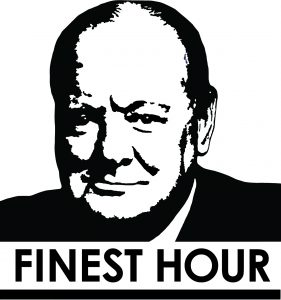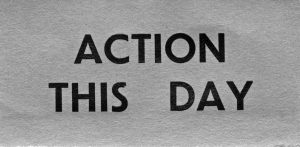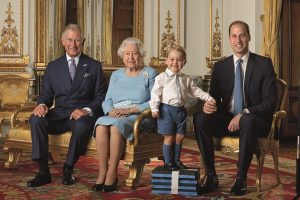
Finest Hour 184
Books, Arts, & Curiosities – Churchill as Literary Character: WSC in Fiction

Winston Churchill, Parliament Square, London © Sue Lowry & Magellan PR
June 19, 2019
Finest Hour 184, Second Quarter 2019
Page 48
Review by Michael McMenamin
Michael McMenamin writes the “Action This Day” column for Finest Hour.
H. B. Lyle, The Red Ribbon, Quercus, 2018, 368 pages, $26.99. ISBN 978–1635060041 Portrayal *** Worth Reading ***
Michael Carin, Churchill at Munich, The Metropolitan Press, 2018, $11.95. ISBN 978–0968856956 Portrayal ** Worth Reading **
Novels are rated one to three stars on two questions: Is the portrayal of Churchill accurate, and is the book worth reading?

2025 International Churchill Conference
The Red Ribbon is the second in a series of mysteries set before the First World War featuring Captain Vernon Kell in his early days as head of MI-5 and his “Agent W” (for Wiggins), a nowgrown-up street urchin who once had been a member of Sherlock Holmes’s Baker Street Irregulars. The first book in the series, The Irregular, was set in 1909, where Churchill, as President of the Board of Trade, had a major supporting role [see review in FH 179]. The Red Ribbon is set in 1910, and Churchill, now Home Secretary, has an even larger role than before. Additionally, Sherlock Holmes himself has a cameo appearance.
The plot is woven around three historical incidents, the latter two of which involve Churchill. The first incident concerns a clumsy spying mission by two MI-6 operatives in the summer of 1910 who were sent to Germany where they were captured, tried, convicted, and spent three years in prison. The second incident is the brutal police attack on protesting suffragettes in Parliament Square on 18 November 1910, “Black Friday.” This is part of a subplot involving Kell’s wife Constance who, unknown to him, has gone from being a suffragist supporting women’s suffrage to a suffragette, someone willing to take positive, sometimes physical, action to achieve their goals. She is one of the more engaging and intriguing supporting characters, second only to Churchill. The third incident is the Siege of Sidney Street on 3 January 1911, where Kell and Agent W bring all the plot threads together for Churchill.
Another subplot that runs through the novel, as it did in The Irregular, is the precarious footing of MI-5 in its early days, when its continued existence was always in peril. In The Red Ribbon Sir Patrick Quinn, the head of Scotland Yard’s Special Branch, i.e., the political police, is something of a minor villain in that he wants MI-5 shut down and its official operations (monitoring German sympathizers and catching German spies) given to Special Branch. Quinn, of course, reports to Churchill as Home Secretary, who does not exactly trust an Irishman as head of the political police. He plays Quinn off against Kell, who does not report to Churchill. MI-5 is part of the War Office, so Kell reports to Richard Haldane, the Secretary of State for War.
When Churchill gives Kell an assignment, he protests: “But we work for Haldane in the War Office. I am army. The chain of command.” Churchill does not care and brushes it off: “Chains restrict, chains limit, chains imprison. We shall not be shackled, eh, Kell?…I want you—or your Agent W—to go wherever I put you. I am Home Secretary. I must know more than anyone, more than Quinn, more than Haldane, more than the Admiralty. Understand?”
Kell replies, “Of course, but my—” “Oh, carry on with the spy hunting, of course,” Churchill says. “I shan’t call on you every day… what I need W for is the specialist jobs, inside the inside, my man and my man alone. You must tell no one of this.”
Later in the book, an angry Churchill reminds Kell of his political support when Kell has been tardy in returning his messages. Kell says, “The Service, sir, is stretched. We are under—” “—resourced. It is all we ever hear,” Churchill replies. “You do realize I am the only thing keeping you afloat. Whenever it comes up, the rest of the Cabinet is all for folding you into Special Branch. Is your heart not in it, man?”
This is an excellent series, and, while Churchill will go to the Admiralty later in 1911, I suspect he will appear in later books in the series, since Kell will still be “spy hunting.”
Churchill at Munich is a well-written, engaging, and mostly well-researched “alternate history” that poses the question what would have happened during the Czechoslovakian crisis if Churchill, not Chamberlain, had been the British Prime Minister negotiating with Hitler. The format for the novel is a series of letters from 1936 to 1938 from a British Foreign Office civil servant translator to his former US-based lover, for whom he still carries a torch despite both being married to others. Carin’s portrayal of Churchill is well done and true to his character, but, unfortunately, Churchill does not appear until the last third of the novel when the narrator becomes Churchill’s German-speaking translator.
In all fiction, verisimilitude—a reader’s willing suspension of disbelief—is important. In historical fiction generally and alternate history specifically, it is critical. So, while the novel is well-written, the less you know about Churchill, the more you will enjoy the book. It can be a big thing or a small thing. Churchill constantly calling Mrs. Violet Pearman “Miss Pearman” rather than “Mrs. P” may be a small thing to most people, but it is not what Churchill would say.
A bigger question in the novel is how did Churchill become PM in 1938? Since Churchill was wildly unpopular in the Conservative Party in 1938, the author solves the problem by killing Chamberlain, Halifax, Hoare, Duff Cooper, and Hore-Belisha in the crash of an airplane carrying them to a conference in France on July 21. Okay, maybe. Sir John Simon, the Chancellor of the Exchequer (who apparently missed the plane) then takes himself out of the running, and the narrator speculates Anthony Eden will be the next Prime Minister. Okay, too.
Ten days later, during which the Conservative Party had to have chosen a new leader, given their overwhelming majority in the House of Commons, King George VI appoints Churchill out of the blue, without apparently taking any advice from whoever had to be the Tory party leader by then. Why did the King do that? The narrator offers the following speculation to his pen pal: “George hasn’t forgotten Churchill’s support of the wobbly royals during the months before the abdication. The monarch has had no better friend than Churchill during the last forty years.” If you have already read the feature articles in this issue, you will see the many problems with that interpretation. So I don’t buy it.
A week later, the narrator tells his pen pal, “Churchill has driven a fierce broom through Whitehall. Sackings and demotions wherever his authority can reach. Not a single Chamberlain advisor or assistant has been kept on.” Nope, I don’t buy that either. Winston was a much smarter politician than that: witness how he acted in May 1940 when he did become Prime Minister. If he had done what the narrator suggests in 1938, his government would have fallen to a no-confidence motion by the Conservative Party.
So, those are the things that destroyed verisimilitude for me. If it does not for you or you are just curious as to how Churchill would have handled Hitler at Munich in 1938, go for it. It is interesting and well-written. I was not persuaded, but I will not tell you why. That would give away the book’s secret, and I am a critic, not a spoilsport.
Subscribe
WANT MORE?
Get the Churchill Bulletin delivered to your inbox once a month.





